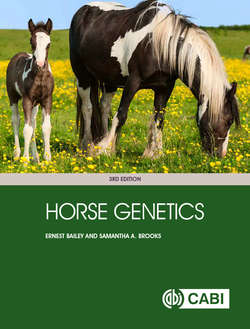Читать книгу Horse Genetics - Ernest Bailey - Страница 68
На сайте Литреса книга снята с продажи.
Dominant and recessive; phenotype and genotype
ОглавлениеThe phenotype of a horse is its measurable appearance. The Extension locus has three genotypes but only two phenotypes (Table 5.1). Why are there three genotypes and two phenotypes? Because the variant for black pigment is dominant over the variant for red pigment. It only takes a single allele for black to allow the horse to make black pigment. There is no difference in appearance between a horse homozygous for E or one that is heterozygous E/e; both will be equally able to make black pigment. In the absence of the gene for black pigment the horse will have the recessive phenotype, chestnut (genotype e/e). If you mate two chestnut horses, the offspring will always be chestnut because there is no way for their offspring to inherit the E allele. However, if you mate two black horses, you might produce a chestnut offspring. This will only happen if both parents are heterozygous (E/e) and can transmit the variant for e to the offspring resulting in a horse homozygous for the chestnut allele (e/e). The relationship of alleles, homozygous, heterozygous, phenotype, and genotype are summarized in Table 5.1 using Extension as an example.
Table 5.1. Chart showing the relationship of genotype to phenotype for the different combinations of the alleles E and e of the Extension gene for coat color.
| Genotype | Phenotype |
| E/E (homozygous for E) | Black and red pigment |
| E/e (heterozygous, both E and e) | Black and red pigment |
| e/e (homozygous for e) | Red pigment only |
A dominant allele is always expressed when present. A recessive allele is only expressed in the absence of a dominant allele. A characteristic that is often useful to know about a recessive trait is that it will always breed true—matings of chestnut horses will always produce chestnut offspring. However, horses with black can produce chestnuts if they are heterozygous. Heterozygous horses possessing recessive alleles hidden by the dominant alleles are called “carriers” for the recessive allele. Carrier means the allele is present but not seen in the phenotype.
It is important to realize that the terms have no meaning beyond the interaction of the two alleles at the same locus. Just as the term “allele” only refers to the relationship of variants at a single locus, dominant and recessive are terms that only apply to alleles at the same locus. Furthermore, dominant alleles and recessive alleles are equally likely to be inherited. Heterozygous transmit the dominant alleles to 50% of their offspring and the recessive allele to the other 50% of their offspring.
